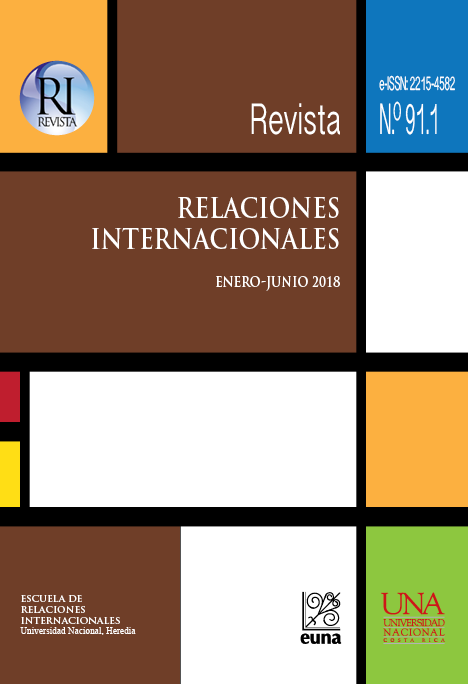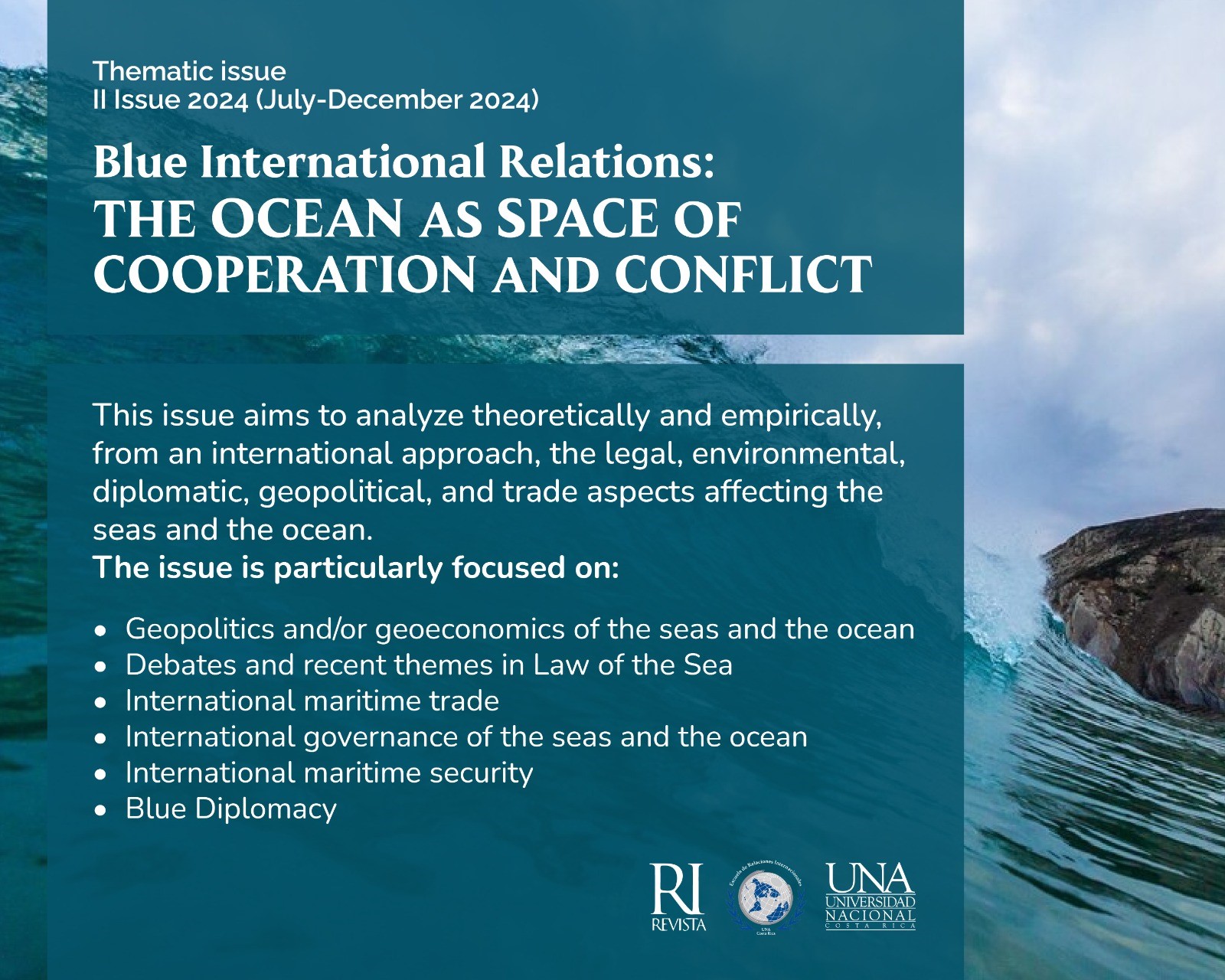Models of relationship in foreign policy. A proposal for analyzing the China South America relations.
DOI:
https://doi.org/10.15359/91-1.3Keywords:
Relational models, Power, National interest, Foreign policy, State, South America, Chinese.Abstract
This paper introduces three relationship models among a weak State and a
strong State for explaining what kind of foreign policy relations exist between them. These models were inspired by Russell and Tokatlian models, called coupling, adjustment, limited opposition, challenge and isolation. The new models presented in this investigation are, opening model, contention model, and strategic alliance model, whose were designed for a multilevel analysis (levels: systemic, state and individual) of relationship in foreign policy among a country of South America and China. The used case study for the appliance of these models, was the relationship in foreign economic policy between Ecuador and China during the period 2007-2016, envisaged by “ideally rational” in Waltz ‘terms (2001, p. 22) about the national interest of the weakest State among them, in conditions that may vary since little favorable until truly favorable. The article suggests according to the case study referred, that exist three possible stages whereby could being explained the relationship among any South American’s country with China according a sort of theoretical-empirical variables, delivering us clues about how could be the China-South America relations in the next years.
References
Banco Mundial. (2017). Sitio oficial del Banco Mundial. Disponible en: http://data.worldbank.org
Bonilla, A. y Milet, P., Edit. (2015). China en América Latina y el Caribe: Escenarios estratégicos subregionales. FLACSO, CAF.
Brown, C. y Ainley, K. (2005). Understanding international relations. New York: Palgrave Macmillan.
Chávez, N. (2015). “América Latina, República Popular China y
Estados Unidos: Relaciones continentales estratégicas”. En China en América Latina y el Caribe: Escenarios estratégicos subregionales, editado por Adrián Bonilla y Paz Milet García, 75-106.
Creutzfeldt, B. (2014). “América Latina en la política exterior china”. En Papel Político, Volumen 18, No. 2. Bogotá: Pontificia Universidad Javeriana.
Dussel, E. (2015). “Comercio y relaciones estratégicas entre América Latina y el Caribe y la República Popular China”. En China en América Latina y el Caribe: Escenarios estratégicos subregionales, editado por Adrián Bonilla y Paz Milet García, 23-50.
Echandi, I. y Morales, F. (2015). “Tendencias de las relaciones de
América Latina y el Caribe con la República Popular de China: Un
balance reciente 2013-2014”. En China en América Latina y el Caribe: Escenarios estratégicos subregionales, editado por Adrián Bonilla y Paz Milet García, 107-126.
Ellis, E. (2014). “The rise of China in the Americas”. En Security and Defense Studies Review. Volumen 16. Agosto 2014.
Foro Económico Mundial. (2017). Sitio oficial del Foro Económico
Mundial Disponible en: https://www.weforum.org/
Gallagher, K. (2013). ¿Un mejor trato? Análisis comparativo de los préstamos chinos en América Latina. Cuadernos de Trabajo del
CECHIMEX.
Hey, J. (1995). Theories of dependent foreign policy and the case of Ecuador in the 80’s. (Tesis de Doctorado en Ciencias Políticas). Universidad de Miami, Estados Unidos.
Intereconomía. (2017). Sitio web de Intereconomia.com. Disponible en: https://intereconomia.com
Kassab, S. (2015). Weak states in international relations theory. The Cases of Armenia, St. Kitts and Nevis, Lebanon, and Cambodia. New York: Palgrave Macmillan.
Mearsheimer, J. (2001). The tragedy of great power politics. New York: W.W. Norton & Company. 555 p.
Ministry of Foreign Affairs of the People´s Republic of China. Sitio
oficial del Ministerio de Relaciones Exteriores de China. Disponible en: www.fmprc.gov.cn/esp/
Ratliff, W. (2009). In search of a balanced relationship: China, Latin America, and the United States. Stanford University. Asian Politics & Policy, Volume 1, No.1, 1–30. Disponible en:
https://doi.org/10.1111/j.1943-0787.2009.01100.x
Reyes, M. (2015). “Las relaciones China - Región Andina”. En Análisis y Pensamiento Iberoamericano sobre China. Observatorio de la Política China. Disponible en: http://www.politicachina.org/imxd/noticias/doc/1443613200jiexi_zhongguo17.pdf
Rosenau, J. (2002). “Preteorías y teorías sobre política exterior”. En Relaciones Internacionales. El Pensamiento de los clásicos. México: Limusa. Editado por John Vásquez.
Rotberg, R. (2002). Failed states in a world of terror. Council on
Foreign Relations. Disponible en https://doi.org/10.2307/20033245
Russell, R. y Tokatlian, J. (2009). “Los retos de América Latina en un mundo en cambio”, en Modelos de política exterior y opciones
estratégicas. El caso de América Latina frente a Estados Unidos, núm. 85-86, Revista CidobD’Afers Internacionals 85-86. Fundación CIDOB, ISSN 1133-6595, Paris, Francia pp. 211-249.
Sotomayor, L. (2018). Modelos de relacionamiento en política
económica exterior: El caso de Ecuador hacia China (2007 – 2016).
(Tesis de Maestría en Relaciones Internacionales con mención en
Negociación y Cooperación Internacional). Quito: Facultad
Latinoamericana de Ciencias Sociales (FLACSO Ecuador).
Waltz, K. (2001). Man, the State and War. Ney York, Columbia
University Press.
Downloads
Published
How to Cite
Issue
Section
License

Revista de Relaciones Internacionales por Universidad Nacional de Costa Rica está bajo una Licencia Creative Commons Atribución-NoComercial-SinDerivar 4.0 Internacional








1.png)







3.png)
